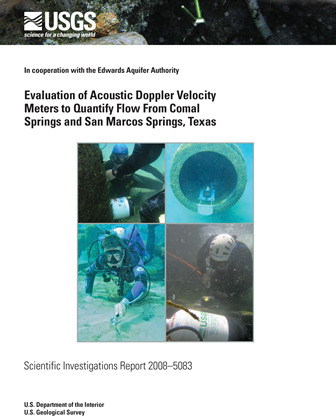Evaluation of Acoustic Doppler Velocity Meters to Quantify Flow from Comal Springs and San Marcos Springs, Texas

| Author | Gary MO, Gary RH and Asquith WH |
| Year | 2008 |
| Description | Evaluation of acoustic Doppler velocity meters (ADVMs) in relation to stream gages to quantify flow from Comal and San Marcos Springs |
| Report Number | USGS 2008-5083 |
| Publisher | US Geological Survey |
| Location | Comal Springs, San Marcos Springs and associated flows |
| Summary |
|
Comal Springs and San Marcos Springs are the two largest springs in Texas, are major discharge points for the San Antonio segment of the Edwards aquifer, and provide habitat for several Federally listed endangered species that depend on adequate springflows for survival. It is therefore imperative that the Edwards Aquifer Authority have accurate and timely springflow data to guide resource management. Discharge points for Comal Springs and San Marcos Springs are submerged in Landa Lake and in Spring Lake, respectively. Flows from the springs currently (2008) are estimated by the U.S Geological Survey in real time as surface-water discharge from conventional stage-discharge ratings at sites downstream from each spring. Recent technological advances and availability of acoustic Doppler velocity meters (ADVMs) now provide tools to collect data (stream velocity) related to springflow that could increase accuracy of real-time estimates of the springflows. The U.S. Geological Survey, in cooperation with the Edwards Aquifer Authority, did a study during May 2006 through September 2007 to evaluate ADVMs to quantify flow from Comal and San Marcos Springs. The evaluation was based on two monitoring approaches: (1) placement of ADVMs in important spring orifices—spring run 3 and spring 7 at Comal Springs, and diversion spring at San Marcos Springs; and (2) placement of ADVMs at the nearest flowing streams—Comal River new and old channels for Comal Springs, Spring Lake west and east outflow channels and current (2008) San Marcos River streamflow-gaging site for San Marcos Springs. For Comal Springs, ADVM application at spring run 3 and spring 7 was intended to indicate whether the flows of spring run 3 and spring 7 can be related to total springflow. The findings indicate that even though velocity data from both discharge features reflect changes in flow, the data do not reliably show a direct relation to measured streamflow and thus to total Comal Springs flow. ADVMs at the Comal River new channel and old channel sites provide data that potentially could yield more accurate real-time estimates of total Comal Springs flow than streamflow measured at the downstream Comal River site. For San Marcos Springs, the findings indicate shortcomings with ADVM installations at diversion spring and in the west and east outflow channels. However, the accuracy of streamflow measured at the San Marcos River gage as an estimate of real-time San Marcos Springs flow could potentially be increased through use of ADVM data from that site. |
Search for Documents
Advance Search
Explore EAA's Scientific Reports
- All Reports
- Weather Modification
- Geology
- Water Use and Conservation
- Geochemistry
- Water Resources Planning and Management
- Floods and Drought
- Water Quality
- Climatology
- Surface Water / Groundwater Relationship
- Biology
- Springs, Groundwater Discharge
- Archaeology
- RZ Protection
- Aquifer Levels
- Remote Sensing
- Precipitation
- Overview Studies
- Modeling
- Hydrology and Hydrogeology
- History
- Groundwater Recharge, Recharge Zone
- Groundwater Movement
- Geomorphology and Caves
